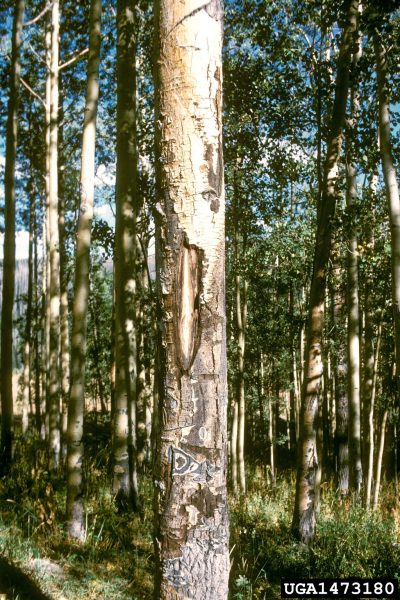






Diagnosing plant ailments is crucial to plant management and health. Cenangium canker of trees is one of the more insidious diseases. What is Cenangium canker? Read on for tips on recognizing, treating and managing sooty bark canker.
Pine, spruce and fir trees provide much needed shade, animal food and cover, and enhance the landscape with their architectural elegance. Unfortunately, these species are prone to fungal diseases such as sooty bark canker, or Cenangium. Over time, the disease can girdle your trees, reducing nutrients and water to the upper growth and preventing the flow of plant starches that feed development. Trees can die without proper treatment.
Cenangium is a fungal disease that produces a slow growing canker that affects the above mentioned evergreens as well as aspens. It is the most widespread canker on trees in the West. Infection begins in July through September when spores germinate and land on damaged or cut parts of the tree.
Once the spores have taken root, they fruit and spread anew. Damage is seen as small oval, dead areas of bark. Over time, it can kill entire branches and in a bad year, spread to all parts of the tree. Fortunately, Cenangium canker of trees is extremely slow growing and tree death rarely results unless it is repeatedly attacked over several seasons and also experiences stresses such as low water and other disease or pest issues.
Sadly, there is no effective Cenangium canker treatment. This means early recognition is essential to managing sooty bark canker. In addition to dead areas of the bark, the needles will begin to brown and die or leaves will wither and fall off. Each year’s growth of the fungus will produce light and dark areas, “zebra”-like girdling of the stems. As the outer bark is eaten away, the interior bark is exposed as powdery and black.
Over time, the canker girdles the stem or branch and it will completely die. In nature, this has a somewhat beneficial effect, helping trees get rid of old limbs. Fruiting bodies are 1/8 inch wide, cup-shaped and gray and granular.
Since there is no effective Cenangium canker treatment, management of the disease is the only option. The only line of defense is recognizing the symptoms early and taking steps to remove infected plant material.
The spores can persist, so it is not recommended to compost the material but rather bag it and send it to the landfill or burn it. Use good pruning techniques when removing diseased limbs. Do not cut into the branch collar and use sterile tools to prevent spreading the spores.
Remove infected limbs as soon as possible before fruiting bodies shoot ripe ascospores into the air in moist conditions. Ascospores are the next generation of the fungus and will rapidly spread in ideal weather climates.
Copyright © www.100flowers.win Botanic Garden All Rights Reserved